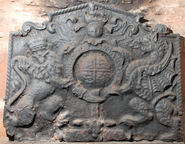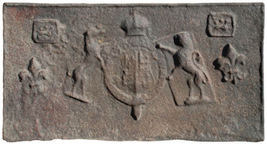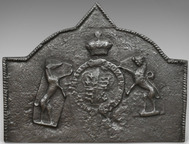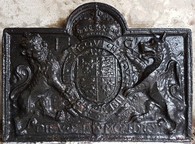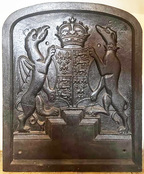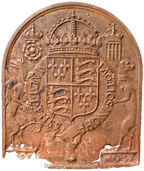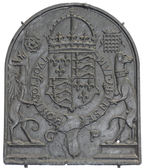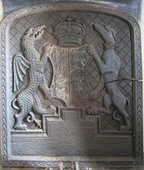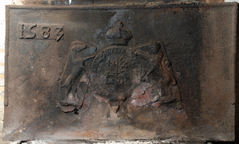-
692
Description: Rectangular with inclined sides, joined by scrolls to a pedimented top; twisted rope edging (top and sides); Garter enclosing the Tudor royal arms, with crowned lion and dragon supporters, helm with chapeau and lion crest, and mantling; rectangular date compartment at base; initials either side of crest.
Notes: The detached pediment is stylistically typical of the late-16th and early-17th centuries. The use of a chapeau or cap of maintenance in place of a crown above the helm is rare in this period. There is an excrescence on the casting over the jaws of the dragon caused by the pouring of the molten metal disturbing the sand mould.
Inscription: E R / Garter motto / 160[?0]
Arms: Tudor royal - Elizabeth I
- Decoration tags:
- rectangular with detached pediment (shape)
- rope (edging)
- whole carved pattern
- individual letters
- individual numbers
- armorial
- royal
- text
Manufactured: in 1600 in England.
Current location: Cothay Manor, Stawley, Somerset, England.
- Attached to series:
- Elizabethan royal armorial firebacks
- Tudor royal armorial firebacks
-
470
Description: Rectangular; twisted rope edging (top and sides); central Tudor royal shield with encircling garter (motto reversed), separate greyhound and lion supporters, separate crown; rectangular bordered stamp with an animal facing to the right, repeated once above and on each side of the armorial; bold fleur-de-lys stamp repeated once on each side of the armorial below the other stamp; all irregularly positioned.
Notes: The armorial and fleurs-de-lys are seen together on a plate at Alfriston Clergy House.
Copies of this fireback are known.
Arms: Tudor royal (prob. Henry VIII)
- Decoration tags:
- rectangular (shape)
- rope (edging)
- carved stamps
- heraldic
- armorial
- royal
- objects
Manufactured: in the early- to mid-16th century possibly at Pounsley Furnace, Framfield in the Weald area of England.
Current location: not known.
Citation: Lloyd, N., 1925, 'Domestic Ironwork I', Architectural Review, 58, pp. 58-67.
- Attached to series:
- Pounsley series
- Tudor royal armorial firebacks
-
51
Description: Arched rectangular shaped, topped with a triangle; twisted rope edging (top and sides only); inverted Tudor royal shield and Garter, crown above, greyhound and lion supporters (see example at Alfriston Clergy House). Two horizontal planklines.
Notes: A uniquely shaped fireback, the inverted shield and Garter indicate that they formed a separate stamp from the crown; other firebacks with these stamps have the shield and Garter the correct way round. A frequently copied fireback; a larger version has a bottom extension.
Copies of this fireback are known.
Inscription: HONE SOVT QUEY MAL Y PENSE
Arms: Tudor royal (prob.Henry VIII)
- Decoration tags:
- rectangular with round arch and triangle above (shape)
- rope (edging)
- carved stamps
- planklines
- heraldic
- armorial
- royal
Manufactured: in the early- to mid-16th century possibly at Pounsley Furnace, Framfield in the Weald area of England.
Current location: Courtlands, Taunton, Somerset, England.
- Attached to series:
- Pounsley series
- Tudor royal armorial firebacks
-
977
Description: Arched rectangular shape; ovolo moulded edging; Tudor royal shield, garter, crown, motto and supporters (crowned lion and dragon), temp. Elizabeth I; initials in space on either side of top of garter; the top of the lion's crown and the dragon's ear overlap the edging.
Notes: The initials have been added to an early recasting; another version has a rose and portcullis either side of the crown, and the top of the lion's crown and the dragon's ear do not overlap the edging.
Copies of this fireback are known.
Inscription: I G / [Garter] HONI SOIT QVI MAL E PENSE / [motto] DIEV ET MON DROIT
Arms: Tudor royal
- Decoration tags:
- rectangular with round arch (shape)
- ovolo (edging)
- whole carved pattern
- individual letters
- planklines
- armorial
- royal
- text
Manufactured: in the mid- to late-16th century possibly in the Weald area of England.
Current location: not known.
- Attached to series:
- Tudor royal armorial firebacks
- Tudor royal armorial (plain) series
-
1286
Description: Low-arched shape within broad fillet edging; on a plain field a Tudor royal shield, quarterly France Modern and England, supported by a stylised dragon and greyhound and surmounted by a crown, all resting on a two-stepped compartment with cavetto- and astragal-moulded edging at the top.
Notes: Pastiche 'Tudor' design by George Shaw of Saddleworth, Lancashire, c.1850, possibly intended to be passed off as genuine Tudor. Another casting in this form is to be found in The Guildhall, Lichfield. More decorated examples exist, with a leaf pattern on the edging and 'scales' on the dragon. Firebacks of the same armorial design within a different, arched rectangular, edging are known.
Copies of this fireback are known.
Arms: Tudor royal
- Decoration tags:
- rounded arched (shape)
- fillet (edging)
- whole carved pattern
- heraldic
- armorial
- royal
Manufactured: in the mid-19th century possibly in the Lancashire area of England.
Current location: not known.
- Attached to series:
- George Shaw series
- Tudor royal armorial firebacks
-
983
Description: Arched shape; cavetto-moulded edge; Tudor royal shield, crown, garter (with inscription anti-clockwise) and supporters (dragon and greyhound); crowned rose on left, and crowned portcullis on right side of crown; the supporters stand on a horizontal fillet, to the bottom right of which is the end of an illegible inscription.
Notes: There are several firebacks with the Tudor royal arms that were probably produced in the Spanish Netherlands, perhaps illustrating the association between England and Spain through the marriage of Henry VIII and Katherine of Aragon. The firebacks differ in several small details, such as the form and rotation of the Garter motto, the style of the crown, the positioning of the supporters in relation to the Garter, and the form and size of the crowned rose and portcullis.
Inscription: HONI SOIT QVI MAL I PENSE / [illeg.]
Arms: Tudor royal
- Decoration tags:
- rounded arched (shape)
- cavetto (edging)
- whole carved pattern
- planklines
- armorial
- royal
- text
Manufactured: in the mid-16th century in the Wallonia area of Luxemburg.
Current location: not known.
- Attached to series:
- Tudor royal armorial firebacks
- Continental Tudor royal armorial firebacks
-
743
Description: Arched rectangular shape; ovolo moulded edging; Tudor royal shield, garter, crown, motto and supporters (crowned lion and dragon), temp. Elizabeth I; the top of the lion's crown and the dragon's ear overlap the edging.
Notes: Another version has a rose and portcullis either side of the crown, and the top of the lion's crown and the dragon's ear do not overlap the edging; a faint blank rectangular stamp on each side of the crown may have been to hide initials, which have been noted on a variant of this fireback.
Copies of this fireback are known.
Inscription: [Garter] HONI SOIT QVI MAL E PENSE / [motto] DIEV ET MON DROIT
Arms: Tudor royal
- Decoration tags:
- rectangular with round arch (shape)
- ovolo (edging)
- whole carved pattern
- planklines
- armorial
- royal
- text
Manufactured: in the mid- to late-16th century possibly in the Weald area of England.
Current location: Victoria & Albert Museum, Cromwell Road, Kensington & Chelsea, Greater London, England.
Museum number: 794.1896 (part of the Victoria & Albert Museum museum group)
- Attached to series:
- Tudor royal armorial firebacks
- Tudor royal armorial (plain) series
-
747
Description: Arch-shaped; fillet edge; Tudor shield, crown, garter (motto clockwise but reversed) and supporters. Crowned rose on dexter, and crowned portcullis (grid of 16) on sinister side of crown; the supporters, a dragon and a greyhound, stand on separate plinths; the initials, G P are placed in either side of the garter buckle.
Notes: There are several firebacks with the Tudor royal arms that were probably originally produced in the Spanish Netherlands, perhaps illustrating the association between England and Spain through the marriage of Henry VIII and Katherine of Aragon. The firebacks differ in several small details, such as the form and rotation of the Garter motto, the style of the crown, the positioning of the supporters in relation to the Garter, and the form and size of the crowned rose and portcullis. Part of the bequest to the Victoria and Albert Museum by Lieut. Colonel G. B. Croft-Lyons in 1926.
Inscription: HONY SOYT QVI MAL Y PENSE / G P
Arms: Tudor royal
- Decoration tags:
- rounded arched (shape)
- fillet (edging)
- whole carved pattern
- heraldic
- armorial
- royal
- text
Manufactured: in the mid-16th century possibly in the Wallonia area of Luxemburg.
Current location: Victoria & Albert Museum, Cromwell Road, Kensington & Chelsea, Greater London, England.
Museum number: M.499-1926 (part of the Victoria & Albert Museum museum group)
- Attached to series:
- Tudor royal armorial firebacks
- Continental Tudor royal armorial firebacks
-
1246
Description: Low-arched shape within broad fillet edging marked with a repeated leaf pattern ascending toward the top; on an incised criss-cross field a Tudor royal shield, quarterly France Modern and England, supported by a stylised, scaly dragon and greyhound and surmounted by a crown, all resting on a two-stepped compartment with cavetto- and astragal-moulded edging at the top.
Notes: Pastiche 'Tudor' design by George Shaw of Saddleworth, Lancashire, c.1850, possibly intended to be passed off as genuine Tudor. Another casting in this form is in Cheetham's Library, Manchester. A variant exists without the leaf pattern on the edging and the 'scales' on the dragon. Firebacks of the same armorial design within a different, arched rectangular, edging are also known.
Copies of this fireback are known.
Arms: Tudor royal
- Decoration tags:
- rounded arched (shape)
- custom with repeated leaf pattern (edging)
- whole carved pattern
- heraldic
- armorial
- royal
Manufactured: in the mid-19th century possibly in the Lancashire area of England.
Current location: Warkworth Castle, Warkworth, Northumberland, England.
(part of the English Heritage museum group)
- Attached to series:
- Tudor royal armorial firebacks
- George Shaw series
-
1041
Description: Rectangular; twisted rope edging (top and upper three-quarters of sides); central Tudor shield, garter, crown and supporters (greyhound and lion), formed from separate stamps; date on a single stamp in top left corner.
Notes: This is an early example of a fireback being used as a pattern, with the addition of a subsequent date. The same stamps forming the arms can also be seen on other firebacks. The extension of the lower part of the ‘3’ on the date stamp suggests that the numbers may have been fixed to the backing block, rather than the date being carved as a whole. Another variant of this fireback has the rope edging extending further down the sides.
Inscription: 1583 / HONE SOVT qVEY MAL Y PENSE
Arms: Tudor royal (prob. Henry VIII)
- Decoration tags:
- rectangular (shape)
- rope (edging)
- carved stamps
- date stamp
- armorial
- royal
- text
Manufactured: in 1583 in the Weald area of England.
Current location: in private hands, West Hoathly, West Sussex, England.
- Attached to series:
- Pounsley series
- Tudor royal armorial firebacks
- Tudor redated series
